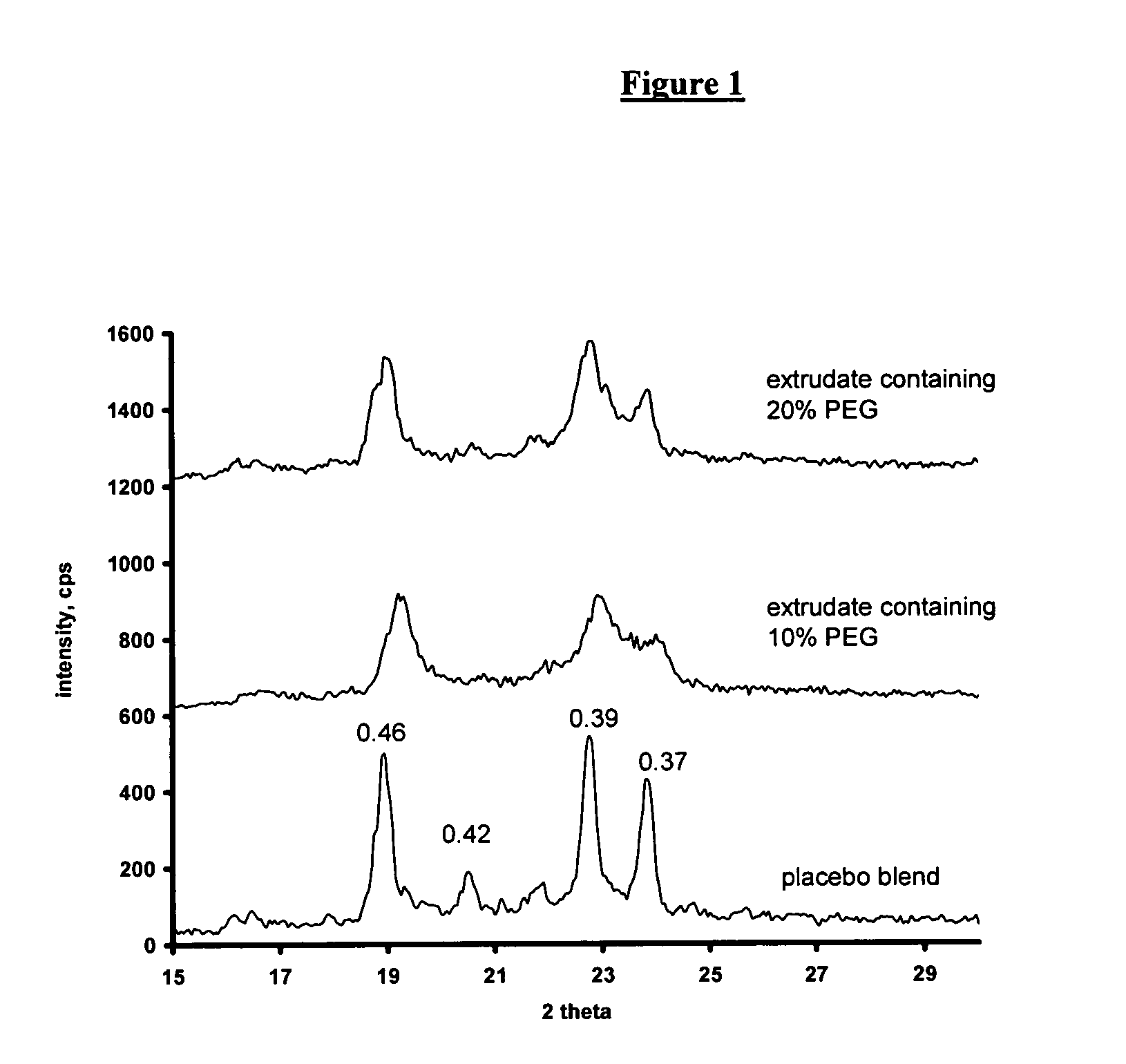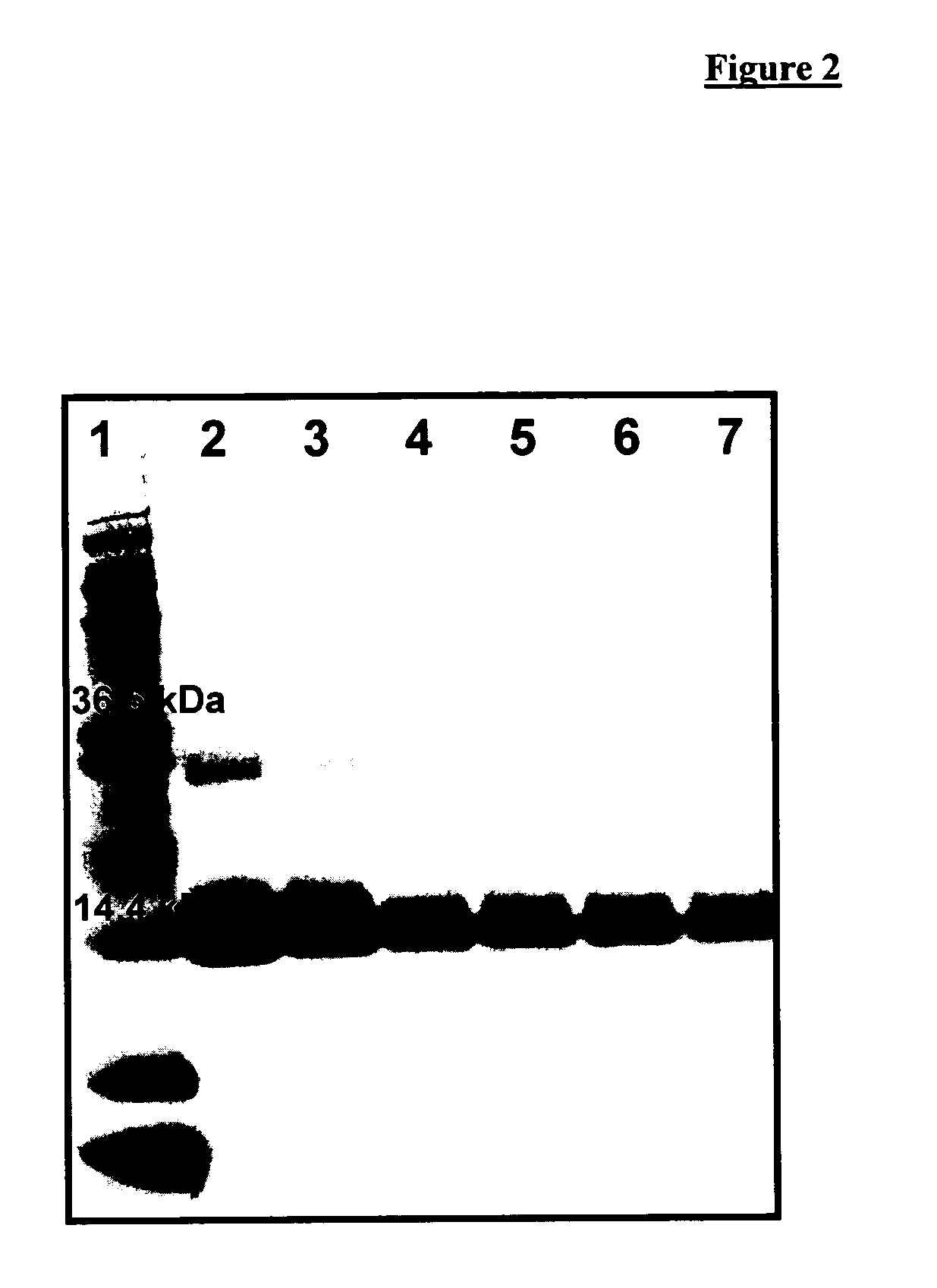Extruded rod-shaped devices for controlled release of biological substances to humans and animals
a technology of biological substances and rods, which is applied in the direction of antibody medical ingredients, peptide/protein ingredients, antibody ingredients, etc., can solve the problems of difficult tasks, and inability to achieve the effect of reducing the number of patients
- Summary
- Abstract
- Description
- Claims
- Application Information
AI Technical Summary
Benefits of technology
Problems solved by technology
Method used
Image
Examples
example 1
[0164]The extruded rod-shaped devices shown in the examples have been manufactured as follows:
[0165]A.)[0166]16% H 12 (triglyceride based on 71% lauric, 27% myristic and 2% palmitic acid, m.p. 36° C., Sasol GmbH, Witten, Germany)[0167]64% Dynasan 118 (gylceryl tristearate, m.p. 71° C., Sasol GmbH, Witten, Germany)[0168]10% PEG 6000[0169]10% IFN α-2a lyophilized with HP-β-CD in a ratio of 1 to 3
[0170]B.)[0171]14% H 12 (triglyceride based on 71% lauric, 27% myristic and 2% palmitic acid, m.p. 36° C., Sasol GmbH, Witten, Germany)[0172]56% Dynasan 118 (gylceryl tristearate, m.p. 71° C., Sasol GmbH, Witten, Germany)[0173]20% PEG 6000[0174]10% IFN α-2a lyophilized with HP-β-CD in a ratio of 1 to 3
[0175]The lipid powder comprising the low and the high melting point lipid was prepared by grinding in a mortar. Subsequently, the obtained blend was admixed with 10% IFN-α / HP-β-CD lyophilisate and PEG, optionally 10% or 20%. Extrusion was performed using a twin screw extruder (MiniLab Micro Rheo...
example 2
[0212]Wide-Angle X-Ray Scattering (WAXS) was performed in order to investigate the lipid modification of the produced extruded rod-shaped devices (according to example 1A and 1B). Lipidic controlled release systems, the pure lipids as well as lipidic blend before manufacturing were ground. Wide-angle X-ray scattering (WAXS) was performed by an X-ray Diffractometer XRD 3000 TT (Seifert, Ahrensberg, Germany), equipped with a copper anode (40 kV, 30 mA wavelength 0.154178 nm). Experiments were conducted at 0.05° (2 theta) within a 5°-40° range.
[0213]As shown in FIG. 1, the freshly prepared extrudates revealed the short-spacings typical for the stable β-modification at 0.46, 0.38 and 0.37 nm [Garti, N., Sato, K., and Editors., Surfactant Science Series, Vol. 31: Crystallization and Polymorphism of Fats and Fatty Acids, 450 Marcel Dekker, New York (1988).]. Therfore, the absence of the α-modification after extrusion was confirmed by WAXS experiments.
example 3
[0214]The experiment dealt with a critical point of the manufacturing procedure: the effects of extrusion on protein stability. IFN-α loaded extrudates were prepared based on the formulations presented before (Example 1A and 1B).
[0215]After extrusion, the protein was extracted with an aqueous extraction method [Mohl, S., The Development of a Sustained and Controlled Release Device for Pharmaceutical Proteins based on Lipid Implants, No (2003).]. Briefly, the protein-loaded matrix was ground in an agate mortar. Subsequently, 50 mg of the sample were suspended in 1 mL pH 7.4 isotonic 0.01 M sodium phosphate buffer containing 0.05% (wt / vol) sodium azide and 1% (wt / vol) polysorbate 20 (PBST). After gentle agitation for 2 hours the samples were centrifuged at 5000 rpm for 5 minutes (4K15 laboratory centrifuge; Sigma, Osterode, Germany). The samples were analysed by SDS-PAGE with subsequent silver staining.
[0216]SDS-PAGE was conducted under non-reducing conditions using an XCell II Mini c...
PUM
| Property | Measurement | Unit |
|---|---|---|
| melting point | aaaaa | aaaaa |
| melting point | aaaaa | aaaaa |
| length | aaaaa | aaaaa |
Abstract
Description
Claims
Application Information
 Login to View More
Login to View More - R&D
- Intellectual Property
- Life Sciences
- Materials
- Tech Scout
- Unparalleled Data Quality
- Higher Quality Content
- 60% Fewer Hallucinations
Browse by: Latest US Patents, China's latest patents, Technical Efficacy Thesaurus, Application Domain, Technology Topic, Popular Technical Reports.
© 2025 PatSnap. All rights reserved.Legal|Privacy policy|Modern Slavery Act Transparency Statement|Sitemap|About US| Contact US: help@patsnap.com



